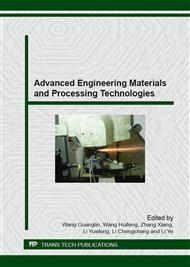p.130
p.136
p.142
p.149
p.155
p.162
p.168
p.173
p.181
Test and Analysis of Low Temperature Air Cutting Performance to Difficult-to-Machine Materials
Abstract:
This paper mainly analyzes the cutting mechanism of low temperature air cutting, and makes research and analysis about the brittle characteristics, the lubricate mechanism and the chip breaking mechanisms of metal materials under low temperature cold condition. Meanwhile, the cutting performance of typical difficult-to-machine materials, such as The precipitation stainless steel, super-alloy and titanium alloy, were discussed. Through cutting experiment under normal conditions and low temperature air conditions, the influence on cutting force, tool wear, chip shape and surface processing quality of typical difficult-to-machine materials were analyzed. The experimental results show that the low temperature air has better effects on cutting difficult-to-machine materials. It can reduce temperature distribution and cutting force, improve tool life and suface processing quality, decrease the use of cutting fluid and mitigate environmental pollution. Thus, low temperature air cutting is an efficient and environment friendly way to solve the problem of cutting difficult-to-machine materials.
Info:
Periodical:
Pages:
155-161
Citation:
Online since:
October 2015
Authors:
Price:
Сopyright:
© 2016 Trans Tech Publications Ltd. All Rights Reserved
Share:
Citation:


